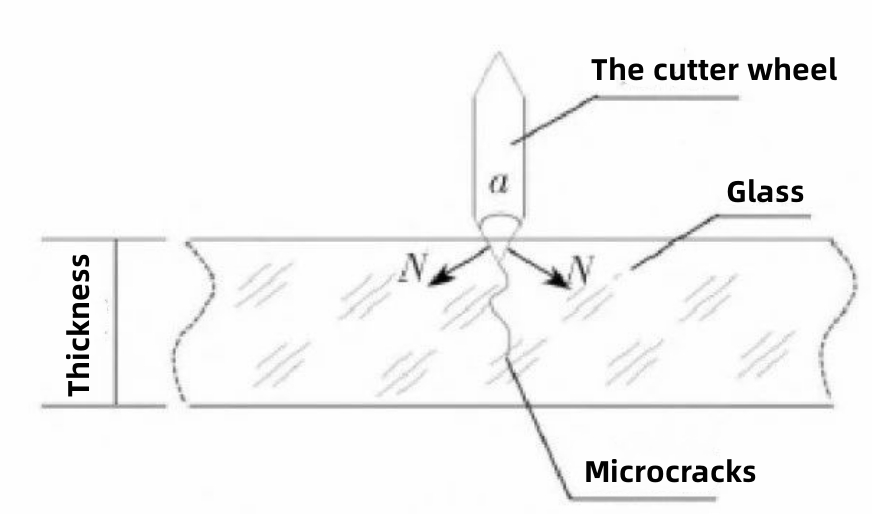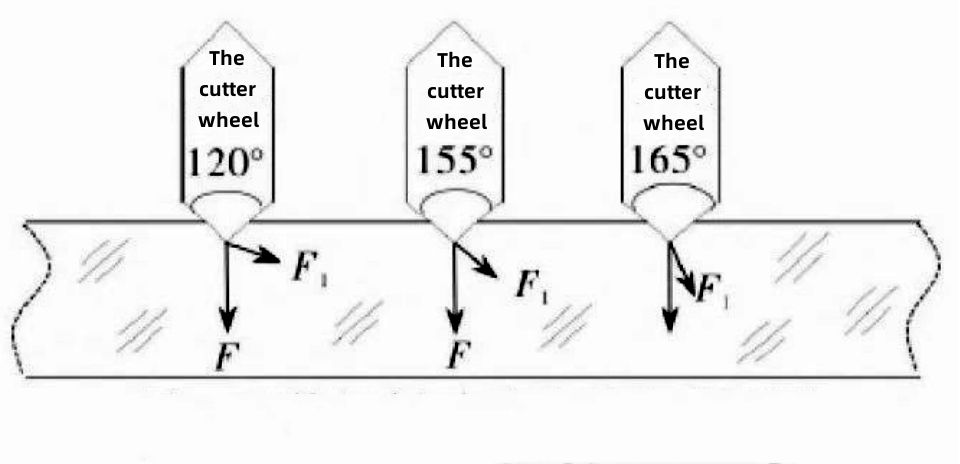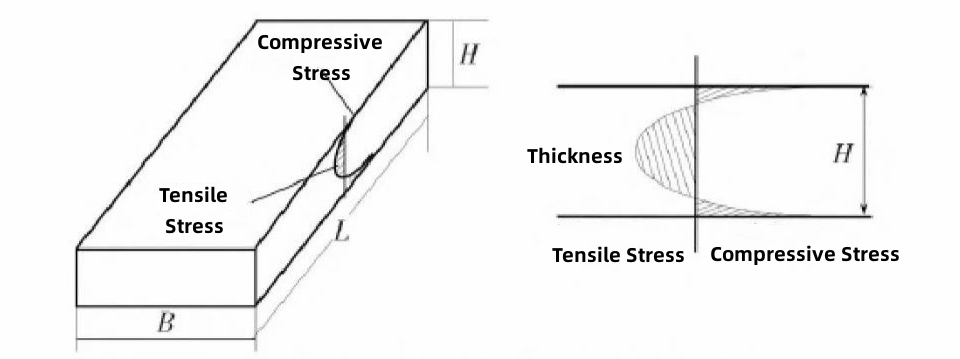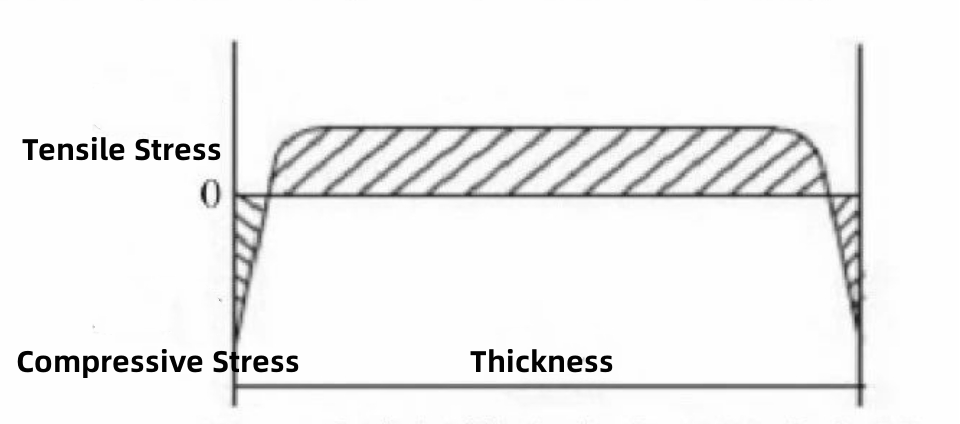Quality control of cutting and edge breaking of ultra-thick and ultra-long float glass.
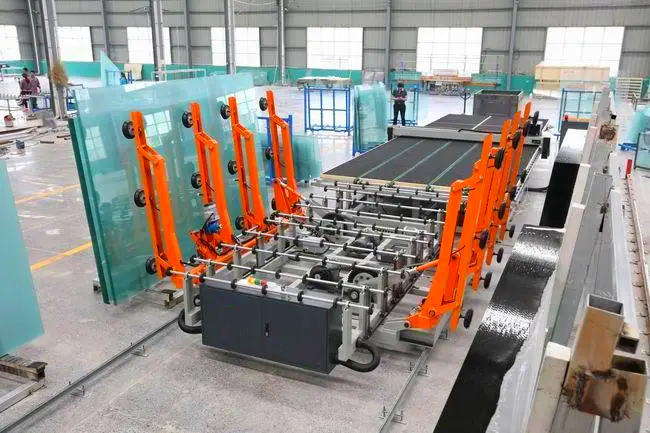
Float ultra-thick glass is widely used in museums, car 4S stores, hotel ground floors, high-end showcases, airports sports venues, etc. Due to the particularity of the field of use, ultra-thick glass is mostly presented in the form of ultra-large and ultra-long large specifications. Due to the difficulty of actual manufacturing, it has become a high-value product. Since most ultra-thick glass is mainly made of ultra-long specifications of 7000mm and above, and the edge-cutting and peeling lines are long, the key points of controlling the quality of its corners are mainly reflected in the edge-breaking process. Improper control will cause two aspects of Hidden dangers: First, safety hazards. If there are jagged edges, concave-convex edges, or small cracks in the broken edges, there may be risks such as splinters in the warehouse or during transportation. The second is poor processability. Flat corners can improve the utilization rate of glass and reduce the difficulty of processing. Therefore, a smooth and regular cutting section can not only reduce the loss of cutting splinters, improve the safety of the storage and transportation of large-size glass products, and improve product processability, but also make the appearance of the glass more refined and more overall aesthetically pleasing, and it is also an important part of the automatic glass cutting production line.
1. Float glass cutting principle
Online cutting of float glass generally uses carbide cutter wheels, polycrystalline diamond cutter wheels, etc. The blades are fixed on the tool holder, and the pressure is transmitted through the solenoid valve to achieve online cutting of the glass. The cutting wheel presses on the glass surface under a certain pressure. When the pressure at the pressure contact position is greater than the strength of the glass surface, a tiny crack will occur on the glass surface. When the cutter wheel rolls on the glass surface, the crack will appear under the cutter wheel and The front keeps expanding to form continuous cutting cracks, as shown in Figure 1.
Figure 1 Schematic diagram of glass cutting
The cutter wheel presses on the crack, and the wedge compresses the crack expansion. The depth of the cutter wheel cut is usually between a few hundred to a thousand microns (the depth depends on many factors, including input pressure, cutter wheel material, shape, blade mouth size, quality, cutting speed, etc.). During the subsequent breaking process, under the action of external force, the upper surface of the glass at the cutting line is subject to greater tensile stress, prompting the cutting crack to rapidly expand through the entire thickness of the glass, thereby breaking the glass plate and the cutter wheel completes the above-mentioned cutting. During the process, it also had some adverse effects on the glass surface. The contact stress exerted by the cutter wheel on the glass surface causes a micro-damage area on the glass surface with a depth ranging from tens to hundreds of microns, producing tiny chips. This debris sometimes appears in the form of larger fragments on the edge of the glass, which affects the cutting quality. In mild cases, the surface of the glass section is not smooth, in severe cases, it forms a jagged shape, or there are obvious small cracks in the section. This may cause the glass to break during transportation, storage, or transportation.
Excellent cutting should be continuous without flying chips (that is, no fragments are generated on both sides of the cut), allowing the glass to crack along the cutting line with a small breaking force. Many factors affect the cutting quality, such as glass composition, chemical uniformity of the glass, stress relief during the glass annealing process, etc. However, the angle of the cutting wheel and the matching of the cutting pressure and the thickness of the glass also have a great impact the cutting quality of the glass. The same cutting line depth has different weakening effects on the local strength of glass with different thicknesses. The thicker the glass, the less the cutting line will weaken the glass. Therefore, ultra-thick glass requires greater cutting pressure and deeper penetration into the glass, making cutting more difficult.
2. Cutting cutter wheel stress analysis and selection principles
The angle of the cutting wheel refers to the angle between the two inclined surfaces of the cutting wheel. Different thicknesses of glass use cutting wheels with different angles. The stress generated by the cutting wheel inside the glass is mainly: downward pressure F and component force F1 perpendicular to the angle of the cutting wheel, as shown in Figure 2.
Figure 2 Stress analysis diagram of glass when cutter wheel cutting
The downward pressure F is the compressive stress required for cutting, and what affects the cutting quality is the component force F1 perpendicular to the angle of the cutter wheel. Due to the influence of the knife on the quality of edge breaking: unreasonable stress distribution will cause the glass to appear jagged, concave, and convex edges, beveled edges, small cracks, or even breakage or chipping when cutting and breaking edges.
Impact on cutting performance: Unreasonable stress distribution will make the cutting process more difficult. The stress will dominate the fracture path, causing the glass cracks to follow the stress distribution, thus affecting the accuracy and stability of cutting. When the stress is too great, the glass fracture will not follow the cutting line, resulting in incomplete cutting or failure to perform normal cutting. The wheel angle is different, and the direction and size of F1 acting inside the glass are also different.
The small-angle cutting wheel produces a large lateral component F1 that is not conducive to cutting. When producing thick glass, if a small-angle cutter wheel is used for cutting when the cutting pressure increases to a certain extent, the transverse component force will have a scraping effect on the glass and a large number of broken glass shavings will be generated on both sides of the cutter wheel, thus continuously releasing the force exerted on the glass. The pressure on the cutter wheel makes the actual downward pressure of the cutter wheel on the glass very small, and it is impossible to cut out effectively and conducive to breaking knife marks. Therefore, ultra-thick glass generally uses a large-angle cutter wheel, which can provide more positive pressure and produce a smaller lateral component when pressurized. Therefore, ultra-thick glass of 15mm and above generally uses a cutting angle of 155°~165°.
The basic principle of selecting a cutter wheel is to use a cutter wheel with a small angle as much as possible while ensuring smooth edge breaking and matching the cutting pressure with the minimum possible to minimize damage to the glass surface. However, in actual production, due to inherent factors such as residual stress in the glass, it is difficult to achieve the ideal cutting state, so reasonable adjustments need to be made according to the actual situation.
3 Brief analysis of stress in ultra-thick glass
3.1 The impact of unreasonable stress distribution on cutting and edge-breaking quality
For ultra-thick glass, it is not only necessary to pay attention to the lateral stress distribution of the glass, but also pay special attention to the stress in the thickness direction of the glass. Unreasonable stress distribution will have a serious impact on the cutting and edge-breaking quality of ultra-thick glass.
Impact on the quality of edge breaking: Unreasonable stress distribution will cause the glass to appear jagged, concave, and convex edges, beveled edges, small cracks, or even breakage or chipping when cutting and breaking edges.
Impact on cutting performance: Unreasonable stress distribution will make the cutting process more difficult. The stress will dominate the fracture path, causing the glass cracks to follow the stress distribution, thus affecting the accuracy and stability of cutting. When the stress is too great, the glass fracture will not follow the cutting line, resulting in incomplete cutting or failure to perform normal cutting.
3.2 Stress distribution of ultra-thick glass
Stress distribution in the thickness direction of ultra-thick glass: Glass is a poor conductor of heat. During the annealing and cooling process, because the glass surface always cools faster than the center, when the glass surface temperature drops to room temperature, the glass center temperature is still higher than room temperature. As the center of the glass continues to cool down to room temperature, the surface has stopped shrinking, but the center of the glass will continue to shrink, causing compressive stress on the surface and tensile stress on the center of the glass, as shown in Figure 3.
Figure 3 Schematic diagram of stress distribution in the thickness direction of glass
Under the same cooling conditions, the thicker the glass, the greater the temperature difference between the glass surface and the center, and the greater the stress generated. When the value of the tensile stress in the center of the glass is very high, it will cause cutting problems, such as rough surfaces, jagged edges, etc. That is to say, when the compressive stress on the upper surface of the glass is relatively high, it will cause the glass to not crack along the cutting line.
Transverse stress distribution of ultra-thick glass: For ultra-thick glass produced by the edge-drawing machine method, the thickness of the edges of the glass ribbon (other than the indentation of the edge-drawing machine) will be significantly lower than the middle thickness. Therefore, when the ultra-thick glass ribbon enters the annealing furnace, within the same width range, the heat brought into the edge glass ribbon will be much lower than that of the middle glass ribbon. Because the edge glass ribbon is thinner than the middle part, its cooling rate will be faster under the same conditions; and because the temperature of both sides of the annealing kiln is usually lower than the middle part. Therefore, the edge temperature of the glass ribbon that enters the cutting area after passing through the annealing kiln is lower than the temperature in the middle. Similar to the principle that stress is generated due to temperature differences in the thickness direction of glass, the lateral stress distribution of the glass ribbon generally presents a distribution state of compressive stress at the edges and tensile stress in the middle. If the compressive stress at the edge is too large, it will be difficult to break the edge of the glass.
3.3 Ideal stress distribution state of glass
When the annealed glass ribbon reaches the cutting area, temporary stress and part of permanent stress remain inside. The size and distribution of the stress are directly related to the annealing process. The ideal transverse stress distribution curve of a well-annealed glass ribbon is shown in Figure 4. The ideal stress state of a glass ribbon that is conducive to cutting is that the edges are subject to smaller compressive stress1 and the middle part is subject to smaller tensile stress. The sum of all compressive stresses is equal to the sum of all tensile stresses. That is to say, if the glass edge is under high-pressure stress, then high tensile stress will be generated in the middle of the glass ribbon. The tensile stress in the middle of the glass is too high, which is not conducive to cutting.
Figure 4 Ideal distribution diagram of transverse stress on a glass plate
4 Ultra-thick glass edge-cutting control
4.1 Material thickness and wall cutting parameters of piano glass
Jinghou glass general cup 155. For cutter wheels with angles of and above, please refer to Table 1 for the longitudinal cutting square and cutting pressure adjustment range.Table 1 Commonly used cutting parameters for ultra-thick glass
| Glass thickness/mm | Cutting knife stroke/mm | Knife wheel angle/° | Cutting pressure/N |
| 15 | 14.5 | 155~160 | 160~200 |
| 19 | 18.5 | 160~165 | 200~240 |
Depending on the cutting mark condition and the actual edge-breaking condition, you can consider increasing or decreasing the pressure appropriately. If the debris on both sides of the knife mark is serious but the edge breaking is still not ideal, the tool needs to be replaced; if the above phenomenon occurs with a new cutter wheel, consider the influence of annealing quality. If the compressive stress on the upper surface of the glass is too large, it is necessary to cool down the inside of the cutting line in advance (such as adding water cooling to the edge).But wait), increase the tensile stress at the cutting line to facilitate edge peeling.
4.2 Cutting oil selection
Cutting oil plays a triple role in cutting extra-thick glass. Protect the cutting wheel and prolong its service life; adhere to debris and avoid splashing; and the most important function is to protect the cut mark - through the infiltration and cooling of the cutting mark by the cutting oil, the cutting oil moves along the cut mark Microcracks continue to penetrate toward the center of the glass, which not only forms certain tensile stress near the glass surface (in the depth direction) but also reduces the tendency of small defects at the cut marks to expand, which is beneficial to improving the quality of edge breaking. Therefore, if the cutting oil evaporates too quickly, it will not be conducive to the infiltration and cooling of the cut marks, and it will easily expand small defects at the cut marks during the edge-breaking process, thereby affecting the edge-breaking quality of the glass.
Currently commonly used cutting oils mainly include: aviation kerosene, glass cutting fluid, cutting agents, etc. Judging from the long-term use in actual production, it is recommended to use glass cutting fluid or cutting agent in the production of ultra-thick glass to achieve better edge-breaking effects.
4.3 Auxiliary border-breaking measures
Viewed from the transverse direction of the glass ribbon, the temperature of the edges of the ultra-thick glass is low, the temperature is high in the middle, the tensile stress in the middle is large, and the compressive stress in the edges is large; in the thickness direction, because the core of the ultra-thick glass plate cools slowly, the upper and lower surfaces cool faster. The tensile stress of the glass core is very large and the compressive stress of the upper surface is large. This makes it difficult to control the edge-breaking quality of ultra-thick glass after cutting. This stress distribution situation is inevitable in the production of ultra-thick glass, but the severity is different. To improve the edge-breaking quality, auxiliary measures are mainly used in the cutting area to change the stress distribution near the cutting line of the glass ribbon. First, a water-cooling device can be installed inside the cutting line for cooling and increasing the tensile stress at the cutting line to facilitate edge breaking. Secondly, use two-edge breaks. That is, two cuts are made on the edge, leaving two longitudinal cutting lines on one side of the glass strip edge. First remove the outermost glass edge from the first cutting line near the edge, which will release part of the compressive stress; remove the edge again at the second cutting line, and you will have better cutting quality. This method is more effective for cutting and edge-breaking difficulties caused by too high stress but is ineffective for situations where the stress is too low.
5. Methods and options for breaking edges of ultra-thick glass
According to the pull-out scale of the float production line and the annealing quality control situation, there are many choices for the edge-breaking method.
5.1 Automatic pressure wheel to press and break edges
When the annealing effect is good, the tensile stress value in the center of the glass is very low and the compressive stress on the surface is also low. When the cutting wheel cuts across the glass, the compressive stress on the glass surface will be released, and the glass can be cut with a little help from other external forces. At this time, a relatively gentle rolling method can be used. For example, a rolling device can be used to lift the glass ribbon by 1~2mm at a position about 50mm inside the glass cut mark, and a pressing method can be used at a position about 120mm outside the cut mark (the tooth mark side of the edge drawing machine). Rolling process, the glass edge gradually moves forward with the glass plate. It has a good effect on improving the quality of the edge section of the glass.
5.2 Automatic stamping and edge pressing
Currently, there are two methods used: single-point stamping and multi-point pressure relief. Single-point stamping edge breaking is prone to amplify the impact of small defects at the stamping point on the quality of the glass edge due to too concentrated stress, so it is easy to produce concave edges or beveled edges at the stamping position; multi-point pressure relief edge crimping method because the glass force points are relatively dispersed and uniform, such defects can be reduced.
5.3 Manual edge breaking
Because most ultra-thick glass products have large specifications (mainly long lengths), and the length of some products even exceeds the limit length of the edge-breaking mechanism in the cutting area (especially some old production lines that have been running for more than 10 years), manual edge-breaking is required. This is the normal process of edge breaking of ultra-thick and ultra-long glass. Manual edge-breaking devices generally use conical plastic hammers or iron hammers, which expand the cut marks by striking and vibrating below the cutting line, and the glass edge cracks along the cutting line. To minimize the impact of tapping action on edge quality, the manual tapping method needs to be adjusted according to the actual annealing situation. First of all, try to use secondary edge breaking to release the stress through primary edge breaking and reduce the impact of the second edge breaking on edge quality. Secondly, if the annealing is good (that is, the edge will easily crack along the knife mark after tapping), you can tap lightly at the starting position of the lower part of the cutting line to create cracks, and then indent or press the upper surface of the glass with an edge drawing machine. Gently tapping the smooth edge outside the mark causes the glass edge to crack and extend backward along with the knife mark. This is equivalent to a gradual "breaking apart" action, which reduces the vibration impact caused by knocking on the lower surface, thereby reducing cross-sectional defects. Third, for glass plates with poor annealing quality, the cracks cannot be completely along the cutting line due to the tapping method on the upper edge. At this time, the lower surface of the glass plate can only be rapped and vibrated in a "high frequency and small amplitude" method. Since poorly annealed glass plates are prone to chipped corners or large bevels, it is best to start the tapping action about 300mm away from the front end of the glass plate. After cracks appear, tap forward again, which can reduce the occurrence of chipped corners. probability. The premise of using this method is to accurately determine whether the problem lies in the cutting wheel, cutting pressure, or poor annealing, otherwise, improper measures will be counterproductive.
6. The conclusion
- The influence of internal stress on the cutting and edge breaking of float extra-thick and extra-long glass cannot be ignored. Reasonable analysis and control of internal stress can not only reduce cracks and damage during the cutting process but also improve cutting quality and efficiency.
- Selecting the appropriate cutting wheel and pressure and taking reasonable auxiliary measures are necessary conditions to ensure cutting quality. The angle of the cutting wheel should match the thickness of the glass. Reasonable pressure and auxiliary measures can reduce the occurrence of cutting and edge-breaking defects.
- The edge-breaking method is an important step in ensuring the cross-section quality of ultra-thick and ultra-long glass after cutting. Using appropriate edge-breaking methods (including different manual edge-breaking methods based on differences in annealing conditions), you can improve the corner quality of ultra-thick and ultra-long glass to a certain extent.
For more information about insulating glass processing equipment and glass processing machinery, please click here to learn more.
